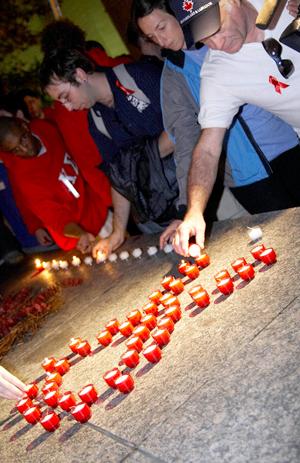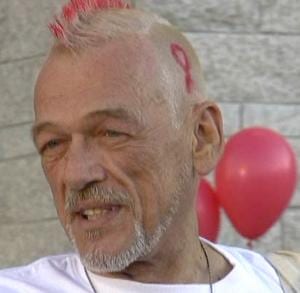
The Ottawa AIDS Walk for Life includes a candlelight vigil at the Human Rights Monument. Credit: Pat Croteau
The Ottawa AIDS Walk for Life was first held in 1989. Since then thousands of people have pinned on the red ribbon and taken to the streets to raise awareness about HIV/AIDS.
The first walk raised little money, but by the end of the decade each walk averaged approximately $45,000. When Jay Koornstra, the executive director of Bruce House, arrived in Ottawa in 2000, he felt that was not enough.
“Somehow it wasn’t doing justice here, in terms of the fact that Ottawa is very unique; it wasn’t just one organization, it was partnership organizations. And you would have thought by the strength of partnerships, rather than one lone AIDS organization, it would appeal,” Koornstra says.
Under Koornstra’s urging, the partner organizations and the coordinator of the walk decided to break with tradition. They moved the walk from Sunday afternoon to the Saturday evening and incorporated a candlelight vigil at the Human Rights memorial. “Saturday evening added a new dimension to it, because it is not only a walk to raise money and awareness, but it was also a way to remember our people,” Koornstra says.
The change worked. In 2001 the walk raised $54,000, and the amount rose steadily over the years, topping $100,000 in 2004. In 2009 it reached a new milestone by raising more than $125,000.
Then came 2010: the US economy was in a spin, Canadians were fearful of its spillover effect, and in Ottawa, the community was divided over a high-profile HIV-nondisclosure case. The AIDS Walk was badly affected, raising only $89,500 that year. The effects were felt by all seven partner organizations: Bruce House, the AIDS Committee of Ottawa, Pink Triangle Services, Planned Parenthood Ottawa, the Snowy Owl AIDS Foundation, the Wabano Centre for Aboriginal Health and the Youth Services Bureau.
“On an agency level, Bruce House took a big hit; on the trickle-down effect, everyone took a hit,” says Koornstra. “These fundraised dollars help to ensure [the partner organizations’] internal programs can best serve their HIV/AIDS portfolio. I would imagine for some organizations it does impact on them greatly — if they don’t receive any support from their parent organization. But, as far as Snowy Owl AIDS, AIDS Committee of Ottawa and Bruce House, our budgeting depends upon that, because it is our mandate.”
The AIDS Walk is a well-oiled machine that requires Bruce House, as the administrating partner, to manage all logistics. Planning starts as early as January, although fundraising kicks in later in the year.
Fundraising is structured into three categories: the Ruby Ribbon circle, which covers costs before the funds are distributed; direct pledges, where donors can specify a particular agency they would like to contribute to; and the general fund, where money is evenly distributed among the partner charities.
In previous years — before 2010 — the Ruby Ribbon patrons, who donate $500 or more, would easily raise the $30,000 needed to cover expenses. Any surplus is divided between the agencies, either through direct pledges or the general fund.
If costs are not met, a formula kicks in to ensure an equitable distribution of expenses. For example, if Bruce House receives 30 percent of pledges, then it covers 30 percent of the expenses as well.
“So, we have the Ruby Ribbon that we hope covers all expenses,” says Koornstra. “The people who donate to the general walk would like to see all the agencies receive some of that money, so we don’t want to ever dip into that to pay for expenses; we want to honour the people who pledge the dollars.”
Fundraising is not the only component of the AIDS Walk.
“We need to continue to educate people. Whether someone thinks HIV is a fatal disease or not, it is certainly a life-altering disease and will infect your entire life in so many ways, shapes and forms,” Koornstra says.
This year Bruce House has made a concerted effort to get youth involved, including appointing students from the University of Ottawa and Carleton University as co-chairs of the event.
“Youth is where it is at right now. Yes, indeed, people of an older age are contracting HIV to a greater extent than before, but youth today seem to not have as much knowledge and information about the severity of HIV/AIDS because they have not lived through a lot of the crisis,” says Koornstra.

 Why you can trust Xtra
Why you can trust Xtra


